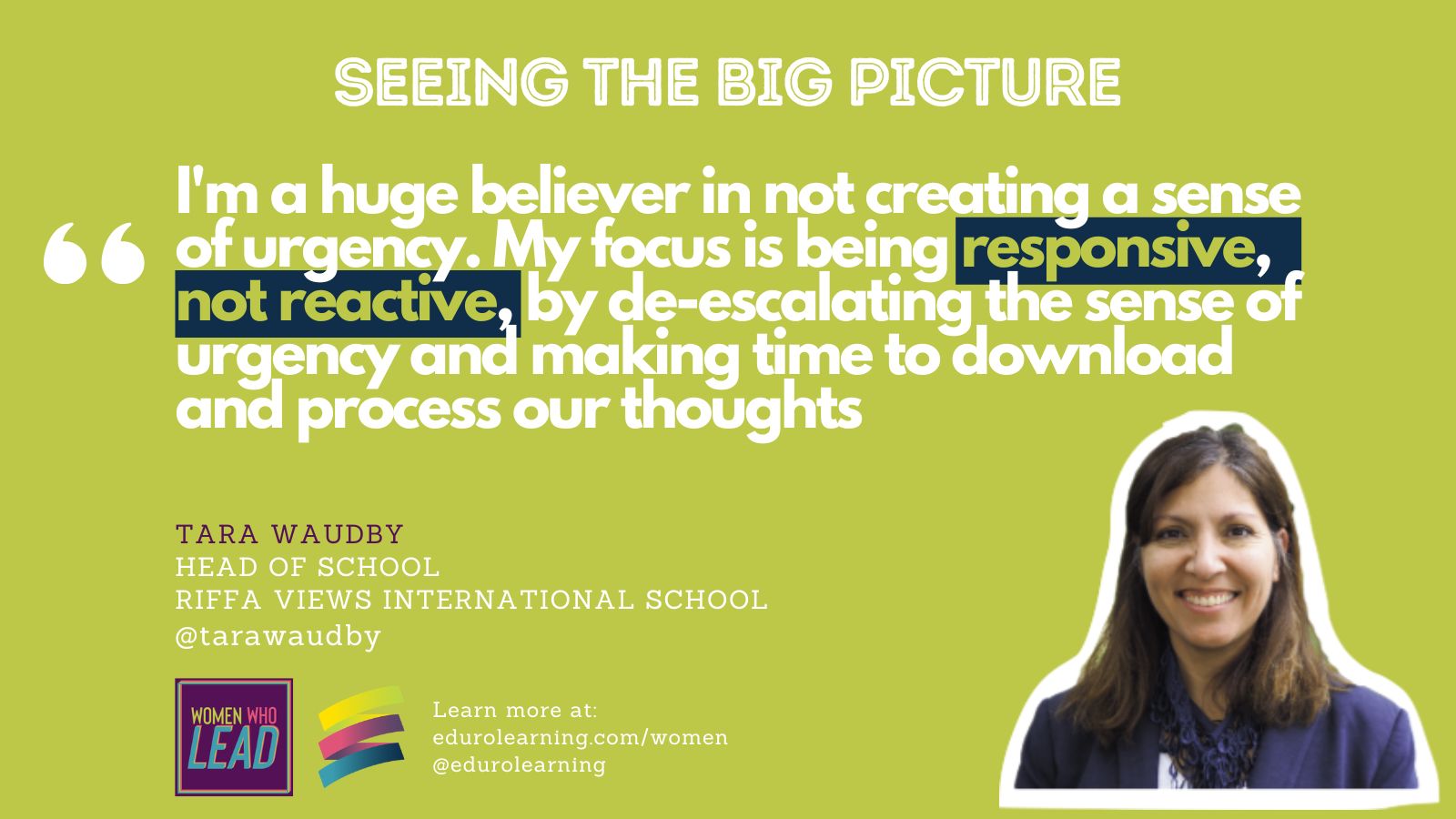
As leaders, not only do we have our own goals and ambitions, but we are responsible for moving our institutions forward. We have goals that range from school-wide to divisional to small group and individual – and we need to progress on all of them, each year. Ideally, all of those goals are grounded in the vision and mission of the school, but that doesn’t always make it easy to prioritize or manage so many responsibilities.
In the Women Who Lead interviews (https://edurolearning.com/women/), I asked our more than 70 successful women how they deal with the many demands of their roles, and what strategies they have developed that work for them.
In my last article I shared strategies that have helped them manage their own daily tasks and interaction. In today’s article I’ll focus on how busy leaders manage the needs of a school or division – from a big picture perspective.
Work With Your Team
Caroline Brokvam, Director American School of Antananarivo, reminds us of the importance of working as a team. She points out that we have 30 years of research that says team decision making is better than individual decision making, and that diverse teams beat homogeneous teams. As a leader, she says, you may be making some decisions on your own, but it’s a lot fewer than you might think – so having processes in place with the people you work with will help you make better decisions.
Likewise, Charlotte Diller, Director of Technology at ISKL, Malaysia, thinks about leadership as a shared responsibility and points out the importance of creating goals together as a team. She notes that you don’t need too many goals (3-5), and stresses the importance of making sure they’re simple enough that you can keep referring to them. If they’re simple enough, you can intersperse them into everything you’re doing. “They become the hooks to hang on all the other things you do. That helps give the bigger focus, are we all working towards the same purpose and goal.”
Although she recognizes the importance of a principal being visible as symbolic leadership, Jennifer Tickle, Secondary Principal at Dresden International School in Germany, says: “It can’t be the culture of Jen, it has to be the culture of the team.” Having shared goals means the strategic plan can be “owned” by everyone. Then, even as priorities change over the course of a busy school year, when you come back to the strategic plan you can remind yourself of the big picture. Having that big-picture view helps you stay positive because you can look at what you’ve been doing and see how you’ve contributed to the overall plan of improvement. That can be a daily reminder that you are making achievements, even if you get caught up in the business of the day to day.
Focus on the Future
Elsa Donahue, Head of School at Vientiane International School in Laos, says that “leadership is not about the now, it’s about what’s coming down the road.” Knowing that, and recognizing her own self-diagnosed ADD, she recognizes that her leadership “can not be about the things that are urgent, it also has to be about the things that are aspirational and inspirational.” She consistently pays attention to the days and weeks ahead so she doesn’t get “stuck in the now.” She builds time in her schedule to think about what’s coming down the road.
Madeleine Heide, Superintendent at Lincoln American School in Buenos Aires, also recognizes that urgent tasks “tend to get immediate play”, but she recognizes that she has to plan ahead for what’s coming. Like many of us, she finds it frustrating to put out the daily fires because she knows that those fires are there because of things that didn’t get dealt with in the past. But, she points out, “the truth is that you have to put out those fires, and then you can plant the seeds and work on the roots.”
Define Your Priorities
Catriona Moran, HOS Saigon South International School, believes that it’s important to be familiar with the theories on prioritization and leadership – but even more importantly, to understand what works best for you. She prefers collecting data, asking questions, and engaging in conversations when she’s prioritizing. Then, she takes the time to share the “why” behind her prioritization with her team. This is important because, “how we define the priority may change, but the rationale and the thinking behind it remains constant.” When teams have a great sense of understanding the “why” behind the priorities, when they are making decisions they can explain which priority we were addressing and why.
Katie Ham, Secondary Deputy Principal at Copenhagen International School Denmark, finds that being authentic and true to herself as a leader helps keep those defined priorities in her focus. Because she has such a strong belief in the school mission and vision, those priorities become part of her narrative and discourse. After articulating them at the beginning of the year, she consistently comes back to them as “the big rocks she’s pushing”. Having those clearly articulated priorities helps – when people ask why they’re not focusing on something, she points back to the established priorities.
Once those priorities are set, Lola Aneke, Executive Director of Cadet Academy, works with her team to split them into quarters (or even shorter time frames), so that whatever comes in between, “unless it’s aligning with what we planned to, unless it’s life or death, we ignore it”. If something comes up that doesn’t align, she uses the priorities to determine how important it is to the goals, before adding something new. Lola also points out the importance of having lots of opportunities for review and recalibration as they go through the year, to make sure daily tasks are in alignment with their goals.
As teachers, we’re very familiar with the concept of backwards design for unit planning. Nadine Richards, Assistant Head Of School for Institution Strategy, Roland Park Country School, believes it’s the same with leadership. She starts with understanding what the vision is, what she’s trying to accomplish. She asks herself: “Where am I trying to go? What do I want to see accomplished in 5-10 years whether I’m here or not?”
Nadine warns leaders that, in the process of team-based design thinking, we can get stuck in the ideation phase so long that nothing is implemented. She points out the importance of action steps after ideation and outlining who will be responsible. What clouds progress and process, according to her, is when it’s not clear what the next steps are to put ideation into implementation. It’s essential to know who is in charge of decision making.
Once Sheena Nabholz, Director of School Relations, Search Associates, has a strategic direction set, she just stays the course. After that, she says, “there’s no more need for wayfinding.” As a former Head of School, she notes that staying the course, and thinking several steps ahead, are important skills, “so you don’t get lost in the noise, or caught up in the urgent and unimportant quadrant” (of the Eisenhower Matrix).
Uncover YOUR Leadership Potentential
Uncover your leadership potential with our new FREE leadership inventory.
This interactive resource highlights the 15 essential skills for emerging leaders that our Women Who Lead referenced in the interviews.
You’ll get a consolidated look at the leadership skills that are essential for leaders today – and the opportunity to reflect on how you’re doing, including your unique strengths and where you have room to grow!
Access the Leadership Inventory here!

Articulate Your Challenges
Arden Tyoschin, Head of School at Harare International School in Zimbabwe, points out the importance of having precise and shared language to ensure that everyone is talking about the same thing. By articulating any challenge you face and giving it language you now have the ability to refer to something directly, rather than talking around the topic. When you’re working with others (as we usually are) this ensures that you’re talking about the same thing. Having precise language and having a shared language is essential when communicating among a leadership team or with community stakeholders. “Being intentional with language is so important when you’re building and co-creating a culture.”
Put Relationships First
Nicole Schmid, HS Principal, American International School Johannesburg, reminds us of the importance of getting out of your office. She says “when the relationships I’m building are working, everything else falls into place.” So much happens when you’re out in the community, so she has a game plan for every day. She looks at her calendar the night before, knowing exactly who she needs to talk to, and when she’ll be out of her office, so she can prioritize her time around their time. She says “I set my priorities around relationships. There’s a sacred time in the day when you have the ability to interact with other human beings that is essential.”
Once you’re in the position of leadership, Kathleen Naglee, Head of School at the International School of Helsinki, cautions that “the work that you need to get done can rarely get done at school. The distraction is the job.” It gets easy to focus on the quick things instead of the important things, so she has learned she needs to write down which are the real things to focus on (and not be so focused on being perfect with the little things). She has to handle the big things, and “the big things are people.”
Process, reflect, then act
Tambi Tyler, Head of School at the Colorado Springs School, knows she needs processing time to make decisions, so asks as many questions about her priorities as she can. Once she gets to a place where it’s time to act, she’s had time to think it through so that the decision has bubbled to the top.
Tara Waudby, Middle School Principal, International School Basel, knows that teachers and leaders often like solving problems, and it’s easy to go into “fixer mode”. When teachers come to her with a feeling of urgency, she focuses on being responsive, not reactive. She listens, stays calm and works to de-escalate urgency, so she can give each party time to download their thoughts. She is a “huge believer in not creating a sense of urgency.”
To do this, she prioritizes entering the day calmly by getting out her thoughts before leaving the house, so she has an easier time not reacting to things. She also created a short decision making matrix, and helps her colleagues practice asking questions so they don’t feel like they have to make decisions right then.
She notes the importance of ontological coaching, paying attention to the language of how we speak. “Just because I’ve listened doesn’t mean I agree.” We need to be explicit about not making assumptions after a conversation, as well as be clear about making explicit requests and stating what’s needed.
Finding Your Personal Process
This article has shared some prioritizing tips and approaches that came up during the Women Who Lead interviews (https://edurolearning.com/women/), but keep in mind that every school context is different, and you may find some of these processes will work in your context, and some may not. Gathering these and other similar examples for inspiration, and testing out different methods, can help you recognize what might work in your setting – but ultimately, you will find yourself creating a process that works for your school community.
If you are looking for more real-life practical stories, examples and strategies like this, that uncover the realities of being a woman in leadership in education, you will love the Women Who Lead Certificate Program. Designed to share the “behind the scenes” stories of over 70 successful women in leadership, this online course will help you find your leadership potential – and learn how to make it a reality. Our next global cohort begins in July, registration opens in May. Find out more here: https://edurolearning.com/women/.
Join the Cohort!
Hear more from our successful women leaders and learn the exact strategies they use to find a space of wellbeing! Learn from the stories of over 70 successful women leaders and build your professional learning network inside Women Who Lead!
Find out more at: https://edurolearning.com/women/.


0 responses on "Seeing the Big Picture"